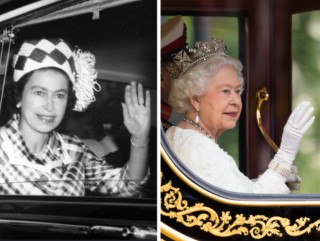
Linguists have documented the ways in which Queen Elizabeth II's accent, often regarded as a standard for formal spoken English, changed over the first six decades of her reign. (Left: public domain photo courtesy of Queensland State Archives on Flickr. Right: photo courtesy of Michael Garnett on Flickr. License CC BY-NC-SA.)
Instructor(s)
Prof. Edward Flemming
MIT Course Number
24.914
As Taught In
Spring 2019
Level
Undergraduate
Course Description
Course Features
Course Description
All languages vary across geographic space and between social groups, and languages are always changing. It makes sense to study these phenomena together because they are intimately related: language change is the basic source of language variation. So studying language change can help us to understand variation, and the nature of linguistic variation provides evidence as to how language changes. Both illuminate the nature of grammar. The course will focus largely on variation and change in phonetics and phonology, and most case studies will be drawn from the English language.


